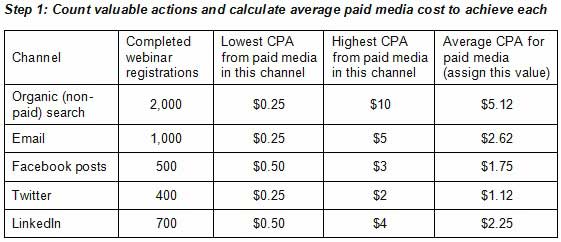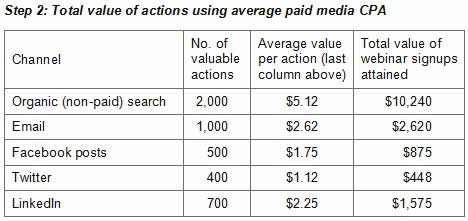Last month we explored the first of two important digital marketing list subscriber metrics: CPA, the cost to acquire a new list member. I also presented a process for determining your maximum allowable CPA—that is, how much it's worth paying or investing to acquire a single subscriber.
This month we'll explore various approaches to assigning economic value to every subscriber already on your list.
Let's start with the clearest way first: the revenue-per-subscriber (RPS) method.
What Is RPS?
Revenue per subscriber (in email marketing commonly termed RPE—revenue-per-email) is a method for determining what each list member is worth to your business in cold hard cash: How much revenue does the average subscriber produce per year? Per quarter? Per campaign?
It's a relatively simple calculation when you can clearly attribute revenue to the specific channel of your list. For example, if you have an email marketing list and want to calculate RPS for the year, take all revenue attributed to your email marketing programs and divide it by the number of valid, deliverable email addresses on your list.
So for example, your annual email RPS might look like this:
- Annual revenue attributed to email marketing: $1,000,000
- Number of valid, deliverable subscribers: 25,000
- Annual email RPS ($1,000,000/25,000) = $40
In this example, on average each email list member produces $40 in revenue per year.
Think about this scenario further: If the average email subscriber delivers $40 in revenue per year, even after factoring in all marketing, operations, fulfillment, and sales costs, you can probably afford to spend at least a dollar or two per person to acquire a new subscriber (your maximum allowable CPA) and still be profitable. Your maximum allowable CPA and profit climb even higher if your costs are accounted for elsewhere (or centrally) and not apportioned by channel.
Whether your list is of mobile, email, or social media marketing subscribers, fans, and followers, the RPS method works. I recommend you calculate RPS both per campaign as well as quarterly and for your full fiscal year.
But: What do you do if you can't clearly attribute revenue by marketing channel? Or if your email and mobile marketing supports sales conversion in other channels but does not drive revenue directly?
Both are legitimate concerns and common when email or social media is used primarily for lead nurturing and content marketing. In that case, let's examine subscriber value from a different perspective.
Average Cost per Action
Even if you can't attribute sales revenue directly to the marketing channel of your list, you can at least track responder actions and assign an average value to each action based on known advertising costs for obtaining said action. And if you can do that, you can equate an action taken by an existing subscriber to a monetary value.
Let's make this easier to understand with a typical scenario.
If, for example, the goal of a content marketing program is to drive online traffic to that content (whether hosted on your site, YouTube, or wherever), then obviously there are a variety of PAID digital marketing and advertising methods you can use to drive traffic. You can use Google Adwords, bid on key search terms, buy digital banner advertising, or invest in display ads on social networking sites like Facebook. You can use paid/promoted posts on Facebook and Twitter. You can pay affiliates. You can advertise in other people's email. (I mentioned many of those tactics in Part 1).
In any of those cases, you might pay based on a cost-per-action (CPA) pricing arrangement—a certain amount per click or page visit or whatever key action you want. Those CPAs range from, on the low end, a few cents per action to several dollars per action. But the point is this: Rates are published, so you have a proxy for determine average cost per action.
So if, for example, regularly emailing your list drives significant Web traffic to and even signups for your webinars, blog posts, or downloadable whitepapers (your content), then calculate what you would have had to pay to drive that same traffic if you didn't have an email list to do the job.
That calculation might look something like this:
- Campaign goal: webinar registration
- Purpose: Webinar attendees make great qualified new leads


In the second table, if 1,000 people from your email list register for the webinar, those actions are cumulatively worth $2,620 (or $2.62 per subscriber). But because you've take the time to build a list of email subscribers it costs almost nothing to send messages to, you're saving thousands of dollars you would otherwise have had to spend to get a comparable result. The same goes for your social media efforts.
Now, if you want to take that $2,620 and apply it across the total number of email subscribers on your list—not just the ones who registered for the webinar—you can do that, too, to calculate the RPS for this campaign. If your deliverable email list in this scenario was 20,000 unique names, then each subscriber in this case was worth on average $0.13 ($2,620/20,000 = $0.13)
Think of it this way: Your email content marketing program contributed $2,620 of value in just this one campaign. Your Facebook activity attributed $875. Your LinkedIn presence and activity... $1,575. And these are values calculated using averages, not extremes.
Imperfect Measures Are Better Than None
I hope you get the idea: Every response action taken by a list member has value. Even if that response action is not a purchase or does not involve a direct sale, it is an action that marketers and advertisers routinely pay for in media channels that are not subscriber-centric.
Whether you use revenue per subscriber (RPS) or average cost per action (CPA) to determine subscriber value depends on both your revenue attribution and your business models. I encourage you to adopt RPS if you can; but, if you can't, then at least attempt to measure subscriber value with the average CPA method. When it comes time to justify your results and ask for more budget, you'll be glad you have hard numbers to show for your efforts.




